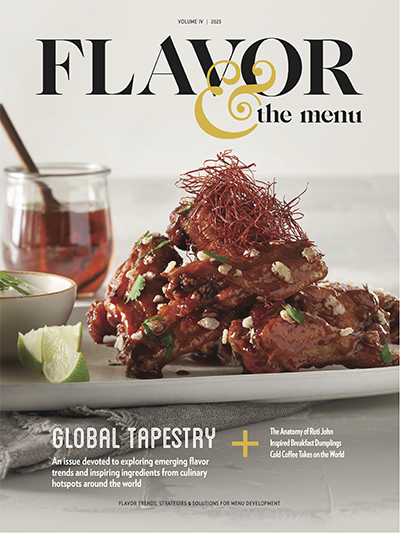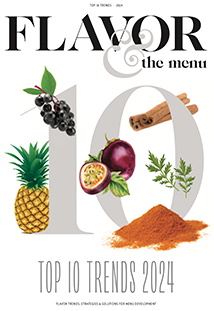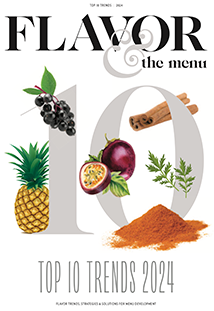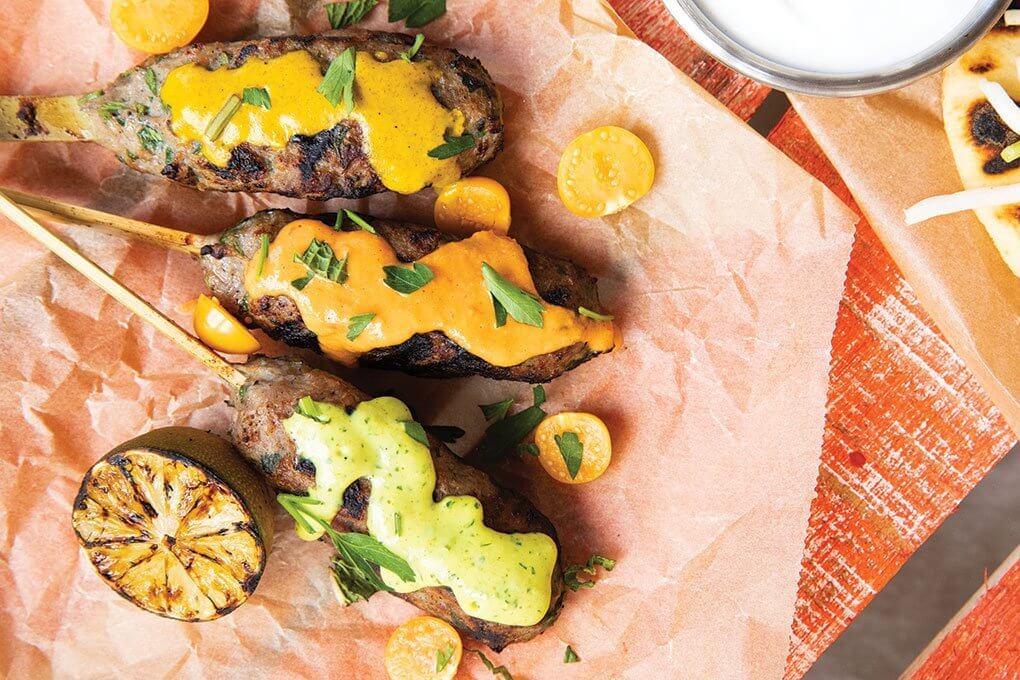Flavor has always been an imperative on menus, but today the expectations are higher than ever. Chefs’ ingenuity is partly responsible—they’re always outdoing themselves and raising the bar with creative flavor combinations. Access to the global pantry, along with a joyful experimentation in mash-ups, has also moved the needle here, raising expectations while making the flavor possibilities endless.
In this modern landscape, adding high-impact ingredients to a recipe build, then, becomes an elemental component rather than a garnish. We tapped a handful of commodity boards, asking for their best examples of menu builds that showcase creative components that pack a significant flavor punch.
The Secret’s in the Sauce
Middle Eastern kofte calls for accompanying flavors that can stand up to its rich and fragrant flavors. (See main picture.) This recipe blends pasture-raised ground Australian lamb with herbs and spices, skewered and grilled over live fire. The aromatic skewers are served with three colorful and flavorful sauces: s’chug, red pepper and curry tehina, which not only bring a great combination of big flavors, but also a nice contrast of vibrant colors to the plate.
The s’chug version in particular steps up the flavor profile of this dish, providing a kick of spiciness that is nicely balanced by the nutty tehina. This sauce, a blend of Serrano chiles, parsley, cilantro, garlic, cardamom, coriander and salt, lemon juice and oil, is a colorful complement for any type of kofte. “S’chug’s vibrant green color inherently cues health and freshness,” says Adam Moore, chef/founder of Flashpoint Innovation and consulting chef for True Aussie Beef & Lamb. “In terms of flavor, s’chug tehina is a fantastic complement to both beef and lamb, with a delicate balance of acidity and spice, along with an earthy foundation of tehina.”
As many high-impact ingredients today hail from the Mediterranean, Middle East and other places around the world where lamb is a staple, the choice of protein lends a storied sense of place.
Dashi Delights
This dish presents a carefully curated mix of ingredients that present bold color, flavor and texture contrasts, all married together with a distinctive yuzu dashi. Sushi-grade salmon, Asian pear, fresh grapes and radishes are drizzled with yuzu dashi and finished with sea salt and micro greens.
The yuzu dashi combines the essence of the sea from the dashi, with the delightfully fragrant but tart, citrusy yuzu juice. This enhanced broth ties the ingredients together into a cohesive dish providing both acidity and freshness with a delicate floral aroma that complements the salmon, the sweetness of the grapes, and the spicy bite of the radish.
“High-impact ingredients such as yuzu dashi provide that ‘Wow!’ factor that makes customers really take notice of a dish,” says Courtney Romano, foodservice consultant to the California Table Grape Commission. “They can offer just the right amount of uniqueness—often in an otherwise familiar combination of ingredients—and thus deliver that memorable dining experience we all crave and will come back for.”
Fresh grapes offer a sweet-acid balance and crisp, juicy texture that enhances high-impact ingredients, whether they are inherently spicy, salty, bitter, sweet or creamy.
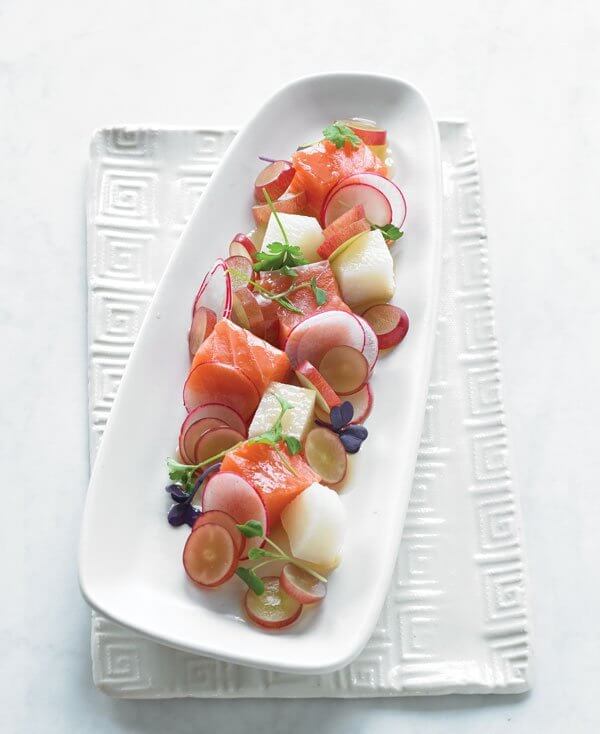 California Table Grape Commission
California Table Grape Commission This dish presents a carefully curated mix of ingredients that present bold color, flavor and texture contrasts, all married together with a distinctive yuzu dashi
Confit on the Side
Originally used as a preservation technique almost exclusively for meats such as duck or goose, many chefs tout the confit technique as having enormous benefits regarding flavor and texture. This plant-forward build sees marble potatoes submerged and simmered in a combination of fragrant olive oil and aromatics, such as Meyer lemon zest and fresh herbs, giving them a rich flavor and tender, silky texture.
The potatoes are then tossed with a Meyer lemon and Dijon vinaigrette, cutting through the richness of the confit. Perfect for a bar menu or charcuterie plate—or as an elegant side dish—this dish highlights the versatility of the potato as a blank canvas for creative flavor combinations and preparation techniques.
“A concept that pairs cost-effective ingredients like potatoes with high-impact flavors and techniques can be a profitable strategy” says RJ Harvey, global foodservice marketing manager for Potatoes USA. “Potatoes make the perfect base to allow high-impact ingredients to shine. Their familiarity encourages chefs to pair them with unexpected flavors or techniques, presenting the perfect opportunity for diners to experience something they may not have tried before with the comfort of an ingredient they love.”
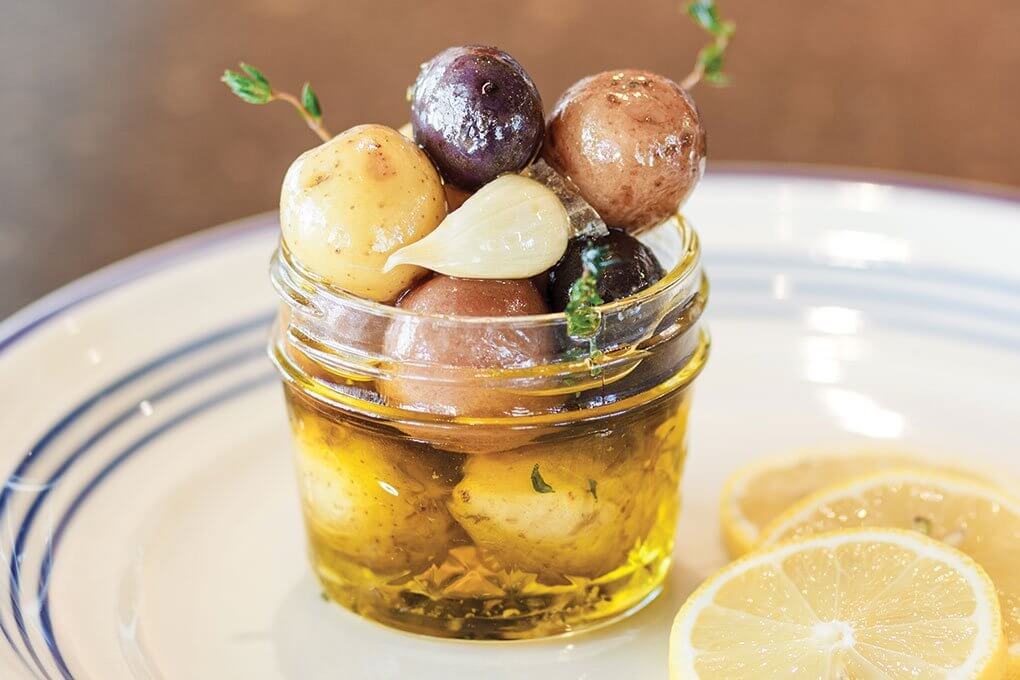 Potatoes USA
Potatoes USA This plant-forward build sees marble potatoes submerged and simmered in a combination of fragrant olive oil and aromatics, such as Meyer lemon zest and fresh herbs, giving them a rich flavor and tender, silky texture
Smoke ’em
Layers of flavor and a complex, grown-up build—even for a coffee beverage—gives this Smoked Honey Shaken Iced Coffee an on-trend edge. Simply prepared with essentially three ingredients—smoked honey syrup, espresso and cold milk—the drink is shaken with ice and garnished with a honey-and-coffee dusting on the rim of the glass.
Here, the smoked honey syrup is the star of the show, achieved by submerging a white-hot hardwood charcoal briquette into a 2:1 ratio syrup of honey and water, which is allowed to cool, then passed through a fine-mesh strainer.
“The smoked honey syrup provides a new level of intricacy and flavor with the familiar sweetness of honey and the warm feeling of a smoky afternoon,” says Jorge Cespedes, beverage and culinary consultant who spearheaded a recent coffee ideation project on behalf of the National Honey Board. This on-trend beverage could easily become a coffee cocktail.
 National Honey Board
National Honey Board Layers of flavor and a complex, grown-up build—even for a coffee beverage—gives this Smoked Honey Shaken Iced Coffee an on-trend edge
Ranch Goes Nuts
For this Crab Salad, sweet crabmeat is tossed with grilled asparagus, red onion, tomato, bacon, lamb’s lettuce, and black pepper peanut brittle, creating an intriguing flavorful crunch. The salad is dressed with a peanut ranch, made with Elmhurst milked peanuts, garlic, onion, celery seed, lemon and peanut oil, adding a unique touch to this well-loved dressing.
Garnished with crushed P-nuff Crunch peanut puffs for added texture, the salad stands out thanks to the specialty dressing and sweet-peppery peanut brittle.
“Approachability is the name of the game in pairing a commodity with high-impact ingredients,” says E.J. Hodgkinson, executive chef at King + Duke in Atlanta, who developed this recipe at a recent National Peanut Board culinary event.
“Utilizing the ingredient to add character and intrigue to otherwise familiar dishes emphasizes the value of the final dish and the perception of value to the guest,” he says.
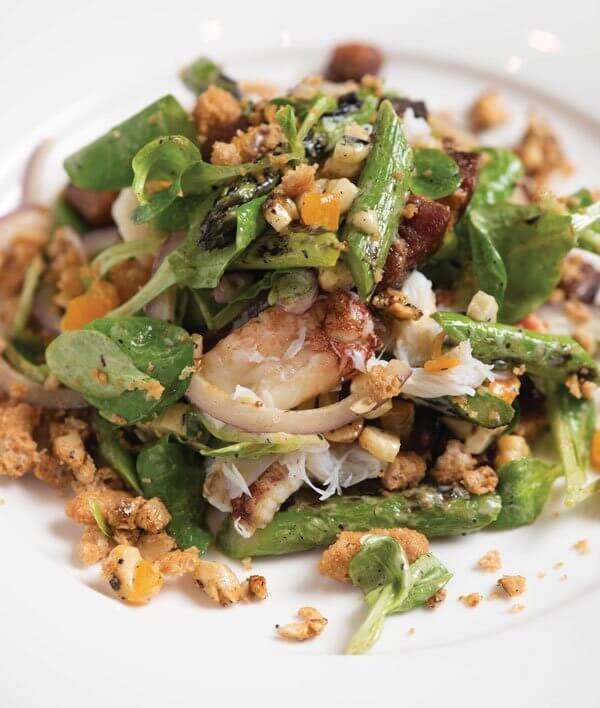 National Peanut Board
National Peanut Board For this Crab Salad, sweet crabmeat is tossed with grilled asparagus, red onion, tomato, bacon, lamb’s lettuce, and black pepper peanut brittle, creating an intriguing flavorful crunch.
Fried Fruit
In a twist on savory watermelon dishes, this Fried Watermelon with wakame salad, cilantro-scallion vinaigrette and pickled radish plates beautifully and provides a unique flavor experience.
Fresh watermelon is breaded and deep fried until golden brown, then drizzled with vinaigrette prepared with lime juice, cilantro, scallion and parsley. Garnished with pickled radish and served with wakame salad, the high-impact component here is the combination of technique and ingredient via fried watermelon.
“I wanted to do something that you don’t see very often,” says Paul Deckenbach, corporate executive chef at Sysco Metro New York, and creator of this dish for the National Watermelon Promotion Board. “By breading and frying the watermelon it changes the expectation from cold and soft to warm and crunchy.”
Boasting a high-end look at an inexpensive price point, this plant-based dish exemplifies how a high-impact component can be a strategic enhancement to operator menus. Variations of this dish might include changing up the dressing to build a different flavor profile or serving the fried watermelon over mixed greens or whole grains like quinoa or farro.
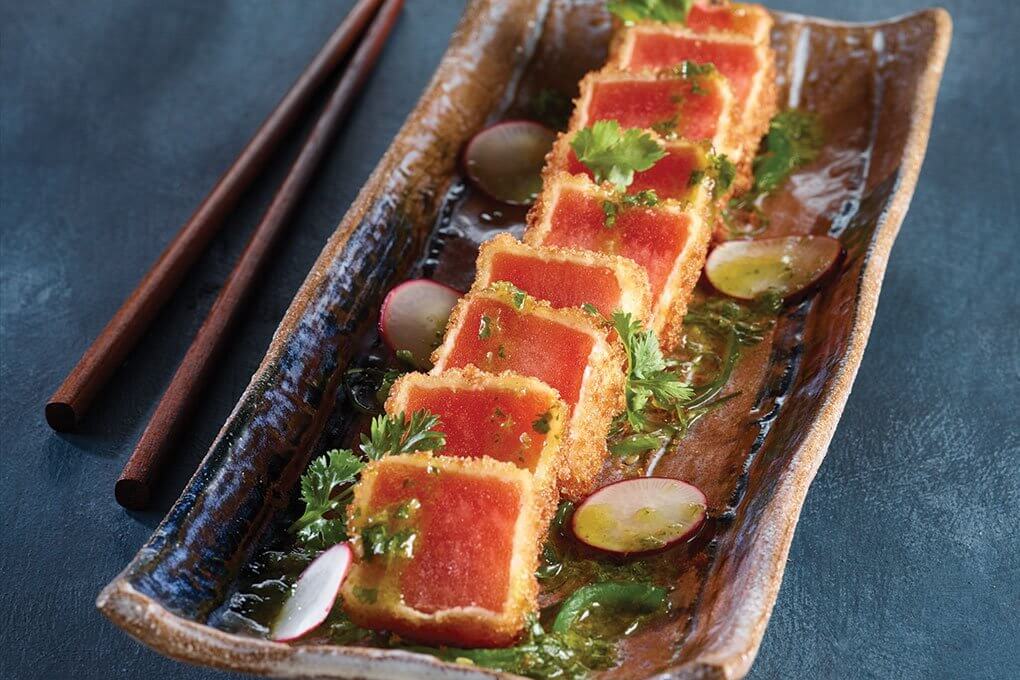 National Watermelon Promotion board
National Watermelon Promotion board This Fried Watermelon with wakame salad, cilantro-scallion vinaigrette and pickled radish plates beautifully and provides a unique flavor experience

